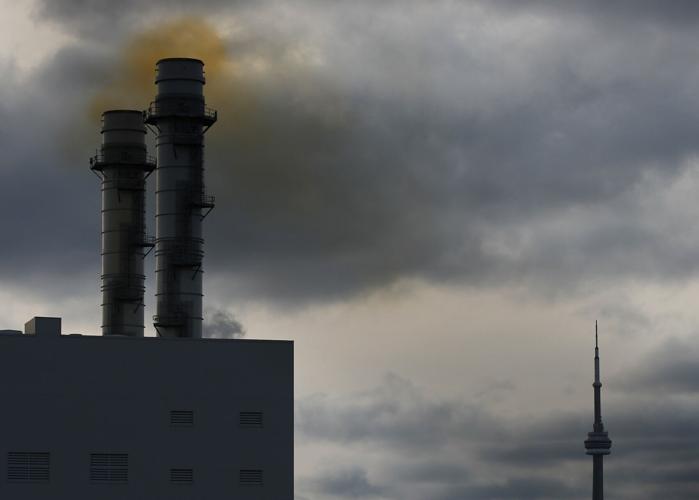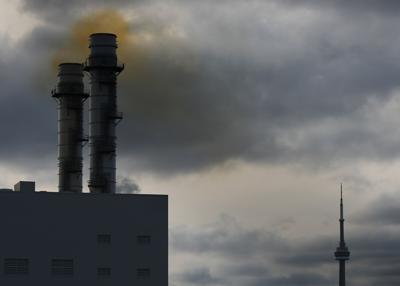Gas plants are polluting like it was 2012.
Ontarioās natural gas power plants were fired up more often last year than they have been in more than a decade, marking a significant regression from the provinceās achievement of almost completely eliminating carbon emissions from the electricity system.
Year end numbers for 2023, published by the Independent Electricity Systems Operator, show 19.1 Terawatt hours of electricity was generated by burning natural gas, a particularly potent greenhouse gas mostly made up of methane.
That is 26 per cent more than 2022 and the most gas plants have been used since 2012.
Ontario, which as recently as 2017 boasted of a grid that was 96 per cent non-emitting, is now only 87 per cent carbon-free.
“It should be shocking to the people of Ontario that we’re going in exactly the wrong direction in a time of escalating climate crisis,” said Tim Gray, Executive Director of Environmental Defence.
“Never before in history have clean alternatives been cheaper or more accessible. It’s an ideological commitment to fossil fuels at the expense of consumers wallets and the future survival of our society.”
In a statement to the Star, Energy Minister Todd Smith defended the increased use of gas plants as a temporary measure necessary to provide energy until non-emitting generation, like nuclear, can be built.
“Ontario continues to have one of the cleanest electricity systems in the world, with a plan to build new clean generation, including nuclear, to further reduce emissions from the sector,” said Smith. “The Independent Electricity System Operator has been clear that in the short term more natural gas would be needed to keep the lights on.”
Gas plant use has doubled in the last three years and tripled since Premier Doug Ford came to power. With the ongoing refurbishment of nuclear reactors at Darlington and Bruce, which requires units to be taken out of service, the provincial grid operator has projected gas plant use will continue to riseĀ ā and so will emissions. The question is for how long.
Last year, the IESO projected that electricity emissions would more than quadruple between 2023 and 2026 and continue to rise afterward. This year, the grid operator revised its projections, showing as “new non-emitting generation is added.”
In one of his first actions after being elected in 2018, Ford cancelled the construction of all renewable energy projects. Late last year, he reversed course and put out a call for new renewable energy. But none is expected to come online until the end of the decade.
In the meantime, the province has been attempting to procure 1,500 megawatts of new gas plants and 2,500 megawatts of battery storage to meet growing peak demand. Indeed, while overall electricity demand has remained stable, the amount of energy required during peak days ā typically in the summer when energy demand spikes as people crank up their A/CĀ ā was significantly higher in 2023 than the year before.
The provinceās fleet of gas plants are intended to be āpeaker plantsā used only as a last resort when demand rises beyond what all the other non-emitting sources can provide.
A Star investigation, published last fall, however, revealed that the plants are already being used far more than intended. The 12 biggest gas plants in Ontario ran on average more than 12 hours a day last year. In the GTA, where plants emit toxic pollutants in proximity to millions of peopleās homes, they ran even more: nearly 15 hours a day.
Last summer, when electricity demand was highest, the GTA plants in Toronto, Brampton and Halton Hills were fired up more than 19 hours a day. The Portlands plant, located on the waterfront in downtown Toronto, ran the most: nearly 21 hours a day.
This growing reliance on gas plants means more planet-warming carbon emissions and local air pollution, which has been shown to cause adverse health consequences.
“Gas plants produce nitrogen oxides, which of course cause respiratory problems. The more you run the gas plants, the greater the health impacts, the greater the health system costs,” said Environmental Defence’s Gray.
Looking forward, electricity demand is expected to rise by 60 per cent by 2050, driven by the electrification of industry and mining, the adoption ofĀ EVs,Ģżthe growth of EV manufacturing, as well as the switch to heat pumps.
To meet this longer term demand, the province plans to build a new generation of nuclear plants, both large scale and small modular units. Critics say the new nuclear designs are untested and point out that nuclear plants have historically taken longer to build and cost more than promised.
“There’s always massive cost overruns, which hits all of us in the pocketbook, but the time delays mean they don’t get done on time. This locks in reliance on polluting gas for much longer,” Gray said.
Meanwhile, renewable power, likeĀ solar and wind, have become the cheapest source of energy and construction is booming, with world governmentsĀ ā including CanadaĀ ā pledging to triple installed generation by 2030. Energy Minister Smith has promised “a regular cadence” of renewable procurements.
“Starting around the end of this decade, Ontarioās electricity system is expected to become cleaner every year. As new non-emitting supply comes online and nuclear refurbishments continue, every unit of electricity used to power a vehicle, home, or factory will be less emissions-intensive. This will enableĀ substantial emissions reductions in other sectors such as transportation and steel manufacturing. By 2035, Ontarioās electricity sector is forecast to reduce emissions in the broader economy by at least three times the amount it produces,” IESO spokesperson Andrew Dow said in an email.
That’s not soon enough to effectively combat climate change said Jack Gibbons, chair of the Ontario Clean Air Alliance and a former commissioner of pc28¹ŁĶųHydro.
āWe are going in the wrong direction. We need to triple our wind and solar power so that we can phase-out gas power by 2035.ā































To join the conversation set a first and last name in your user profile.
Sign in or register for free to join the Conversation